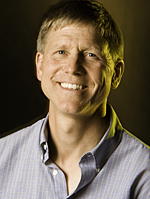
David Sammeth
Las Vegas, N.M. — New Mexico Highlands was awarded a National Science Foundation grant for a state-of-the-art Luminescence Dating Laboratory to chronologically date Earth sediments and archaeological artifacts, making it the first university in the state to offer this research capability onsite.
The university’s two-year $384,926 NSF grant will be used to purchase cutting-edge instruments that will be used for thermal luminescence dating and optical luminescence dating. Some research applications include determining how long a sample of sediment has been buried or the time since a clay pot was fired.
The principal investigator and author of the NSF grant proposal is longtime Highlands University chemistry professor David Sammeth, who also heads the university’s Laser Laboratory.
“The new instrumentation will measure the amount of energy that has been stored in a sample and how long it took to accumulate the energy, letting you know how old the sample is,” Sammeth said. “With optical luminescence dating, a laser is used to release the stored energy in a sample by giving off light called luminescence. With thermal luminescence dating, the samples are heated in order to give off light.”
Sammeth said there are many research applications for the new instruments, ranging from dating sediments in a dried up lake bed to dating an archaeological artifact like a pot shard.
“Luminescence dating is used to investigate sedimentary processes back to 200,000 years or more,” Sammeth said. “The ability to place events in a temporal context enriches our understanding of transformations that are an integral part of understanding the physical and cultural world we inhabit.
“Luminescence dating research tells us how the land we live in is changing over time and helps answer fundamental questions about what kind of world we will need to adapt to in the future as the Earth’s climate changes,” Sammeth said.
During a sabbatical fall semester 2011, Sammeth gained hands-on experience using the time- dating instruments for research.
“I learned from experts at the USGS Lab in Denver about geologic applications, the University of Washington about archaeological applications, and UCLA about theoretical applications,” Sammeth said.
He added that the new instruments at Highlands will be used to cross-reference other chronological dating techniques such as carbon dating and dendrochronology — tree ring dating.
Sammeth plans to develop a luminescence dating course with a laboratory component where students will learn how to use the new instruments. He said the lab will also offer new opportunities for both undergraduates and graduate students to conduct their own research.
“This luminescence dating lab will enhance existing science research at Highlands, as well as enable faculty and students to conduct new research,” Sammeth said. “Through cross fertilization of disciplines, new research and ideas develop. Collaborating with scientists in other disciplines is an important goal of this new lab.”
Highlands University anthropology professor Warren Lail has already collaborated with Sammeth on one archaeological study and is looking forward to future research collaborations.
Lail and Sammeth’s joint study, “A Non-Destructive Method for Dating Human Remains,” is targeted for the journal Advances in Archaeological Practice. The study usesoptical luminescence dating to analyze soil compacted in a human cranium without damaging the bone.
“This type of time-dating equipment is rare even at the largest research institutions across the country and it’s very expensive,” Lail said. “For archaeology and forensic anthropology, this lab will give us new options for dating soil in and around artifacts. This opens up new avenues for research.
“Environmental reconstruction is an important part of archaeology and now with luminescence dating, we can determine when the sediments were deposited on the site. This will help answer the question of when humans abandoned a site, which is an important piece of the puzzle in archaeological research,” Lail said.
He added, “Luminescence dating is a very specialized field that requires advanced equipment and the kind of expertise Dr. Sammeth has. This new lab will be very significant for research at Highlands and beyond.”
